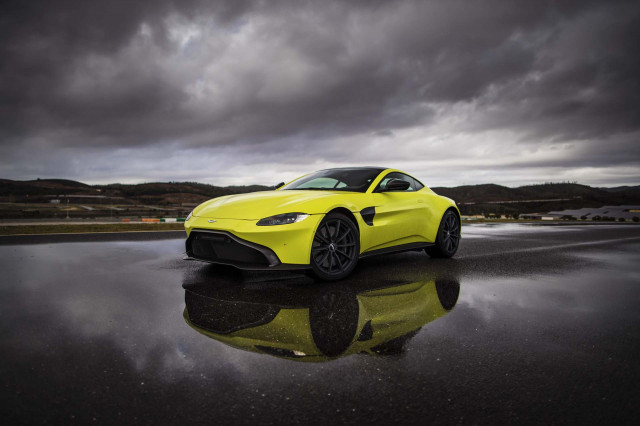2019 Aston Martin Vantage first drive review: tilting at windmills
The giant blades on the lazy-looking wind turbines that dot southern Portugal produce the sound of a passing jet, only it never goes away. I know this because the irresistibly photogenic windmills got me out of the 2019 Aston Martin Vantage’s driver’s seat. Not much else would.
The Vantage’s avant garde styling is driven by aerodynamic demands almost as much as it is the need for a new persona for the brand. The front air intake and splitter not only manages airflow around and under the car but it is purposely ostentatious. It appears that Aston Martin is tilting at windmills.
CHECK OUT: 2018 BMW M5 video road (and track) test
When the goal is stability at a top speed of 195 mph, airflow management is crucial. Equally critical is the need for Aston Martin to graduate from the ranks of stodgy heritage brands and vault itself firmly into the future. The forthcoming Valkyrie hypercar, co-developed with the Red Bull Formula One team and designed by its aerodynamicist extraordinaire, Adrian Newey, will surely shift perception of Aston Martin forever.
But the $3 million Valkyrie will be available in vanishingly small numbers, fewer than 200 total between the street cars and track-only versions. Own one? You may never see one. The Vantage, on the other hand, is Aston’s best-selling model, with 21,500 examples of the outgoing generation produced. The aim is to get a bunch of these new $150,000 Vantages out on the streets where they will remind viewers of the Valkyrie, not of some fictional British movie spy’s musty old car.
“You have some very strong graphics,” explained Thomas Leret, color and trim design manager at Aston. “It is very three-dimensional, more intricate and complex than before,” he continued. “It gives a modern character to the car.” For a brand seeking to escape the amber in which it is in danger of becoming fossilized, this is critical.
He’s right. The aerodynamic-focused styling is more expressive, and the controversial bits sit very low on the car, where they aren’t as apparent when viewed from standing height, as opposed to the ground-level perspective beloved by photographers. The sloping hood looks very low, and by itself helps pull the Vantage out of the past.
The retina-searing Key Lime hue that appears as a main body color and as a highlight on more subdued cars was inspired by shoes and sports attire from Nike and Adidas, Leret reported. The aim is convey a lightweight, sporty impression.
That begs the question, is it lightweight? Lightness is relative in these days of small overlap and roof crush crash tests, but in its lightest available configuration the Vantage weighs in at 3,373 pounds. That compares to 3,153 pounds for the lightest Porsche 911 and 3,298 for the Chevrolet Corvette, so it could be lighter, but it’s in the ballpark.
DON'T MISS: 2018 Aston Martin DB11 V8 first drive review: with a little help from friends
Any additional mass is not apparent on the road, where the Vantage’s perfect 50/50 front/rear weight balance and its stupendously rigid aluminum chassis yield a sterling combination of excellent balance, road feel, and ride comfort.
The Vantage is Aston’s second model on the company’s new aluminum chassis, which is a substantial improvement over its first-generation aluminum VH platform. The Vantage’s chassis is 11 percent more torsionally rigid, at 35,000 newton-meters per degree of deflection, compared to 27,000 Nm/degree for the DB11.























































Email This Page